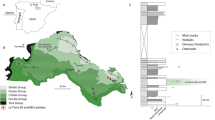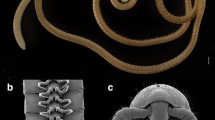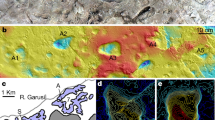Abstract
A unique, complex trackway has been discovered in Scotland: it was made roughly 330 million years ago by a huge, six-legged water scorpion that was about 1.6 m long and a metre wide. To my knowledge, this is not only the largest terrestrial trackway of a walking arthropod to be found so far, but is also the first record of locomotion on land for a species of Hibbertopterus (Eurypterida). This evidence of lumbering movement indicates that these giant arthropods, now extinct, could survive out of water at a time when the earliest tetrapods were making their transition to the land.
Similar content being viewed by others
Main
The trackway (Fig. 1a, b) is exposed on a bedding plane close to the base of a sandstone section in a non-marine sequence. It is 6 m long, 0.90–0.98 m wide and consists of sinuous, paired belts of appendage prints flanking a sub-central groove. The trace-maker had at least three pairs of appendages of different lengths (heteropodous), which moved in phase. The longest, outer limbs left elongated crescent-shaped prints (series A in Fig. 1b, green), which overlap slightly or coalesce into a linked series of arcs. The stride length is therefore less than the series-A print length (average, 0.27 m) and indicates that the animal was crawling extremely slowly.
a, View of the trackway on the undersurface of an overhanging sandstone bed, which is dipping at 45° away from the viewer. The hammer (arrowed) in the photograph is 30 cm long, but the oblique view affects scale and relative proportions. b, Interpretive diagram showing track features, position of a second, smaller (0.80 m wide) trackway and the position in the rock of microfaults (f–f1), joints and bedding traces (red lines). Arrow indicates movement direction of the animal. Trackway: orange, central groove; series A, B and C are shown in green, blue and yellow, respectively. c, Reconstruction of the hibbertopteroid eurypterid trackway-maker. This arthropod was about 1.6 m. long (for clarity, the limbs on the left of the body are omitted).
Lines of elongate, crescentic or sigmoidal prints (series B in Fig. 1b, blue) lie inside series A, and further elliptical prints (series C in Fig. 1b, yellow), made by the shortest appendages, can be detected inside these. In places, the series-C prints have been erased by the central groove, which was made by the posterior part of the animal. This is trapezoidal in cross-section and its base is deeper at the margins and slightly raised in the centre. Occasional oblique lineations on the sides and base of the groove indicate that the motion was jerky. The sinuous curve of the groove is smaller in amplitude than, and out of phase with (by about 0.5–0.6 m), the trackway margins, which reveals the direction of locomotion (Fig. 1a, b). The slow, stilted progression, together with the dragging of the posterior, indicates that the animal was not buoyant and that it was probably moving out of water.
There are several groups of Lower Carboniferous (Asbian) arthropods that might have been capable of leaving large trackways1, but only the water scorpions, or eurypterids1, are likely to have left the trackway described here. The pattern and character of the limb prints is most consistent with a relatively short-limbed and markedly heteropodous hibbertopteroid eurypterid2,3,4,5 (Fig. 1c). The double-keeled underside of the terminal tail plate of these animals4,5 matches the character of the central groove.
Fragmentary exoskeletal remains of Hibbertopterus and related forms are relatively well known from Scottish Lower Carboniferous rocks2,3,4,5 and were first described from West Lothian in 1831 (ref. 2). The trackway-maker (Fig. 1c) would have been comparable in size to the largest known hibbertopteroid body fossils, which have head shields3,4,5 that are 0.65 m wide.
The short length of the relative stride in the trackway emphasizes the extreme slowness of the gait and differentiates it from other eurypterid trackways within the ichnogenus Palmichnium1,6,7,8,9. This trace is 0.2 m (25%) wider than any other trackway of this type1. The only larger known invertebrate trackway, although also attributed to a eurypterid, is very different in character and appears to have been made by a swimming animal10.
References
Briggs, D. E. G. & Rolfe, W. D. I. J. Paleontol. 57, 377–390 (1983).
Waterston, C. D. Trans. R. Soc. Edinb. 61, 265–288 (1957).
Waterston, C. D. Trans. R. Soc. Edinb. 68, 1–20 (1968).
Jeram, A. J. & Selden, P. A. Trans. R. Soc. Edinb. E 84, 301–308 (1994).
Selden, P. A., Corronca, J. A. & Hünicken, M. A. Biol. Lett. 1, 44–48 (2005).
Braddy, S. J. & Milner, A. E. Can. J. Earth Sci. 35, 1116–1122 (1998).
Braddy, S. J. & Almond, J. E. J. Afr. Earth Sci. 29, 165–177 (1999).
Draganits, E., Braddy, S. J. & Briggs, D. E. G. Palaios 16, 126–147 (2001).
Hanken, N. M. & Stormer, L. Foss. Strata 4, 255–270 (1975).
Almond, J. E. Geobulletin 45, 28 (2002).
Author information
Authors and Affiliations
Corresponding author
Ethics declarations
Competing interests
The author declares no competing financial interests.
Rights and permissions
About this article
Cite this article
Whyte, M. A gigantic fossil arthropod trackway. Nature 438, 576 (2005). https://doi.org/10.1038/438576a
Published:
Issue Date:
DOI: https://doi.org/10.1038/438576a
This article is cited by
-
Increased fire activity under high atmospheric oxygen concentrations is compatible with the presence of forests
Nature Communications (2022)
-
Insights into the 400 million-year-old eyes of giant sea scorpions (Eurypterida) suggest the structure of Palaeozoic compound eyes
Scientific Reports (2019)
-
The evolutionary consequences of oxygenic photosynthesis: a body size perspective
Photosynthesis Research (2011)
-
Muddy tetrapod origins
Nature (2010)
-
Eurypterid trackways from Early Devonian tidal facies of Alken an der Mosel (Rheinisches Schiefergebirge, Germany)
Palaeobiodiversity and Palaeoenvironments (2010)
Comments
By submitting a comment you agree to abide by our Terms and Community Guidelines. If you find something abusive or that does not comply with our terms or guidelines please flag it as inappropriate.




